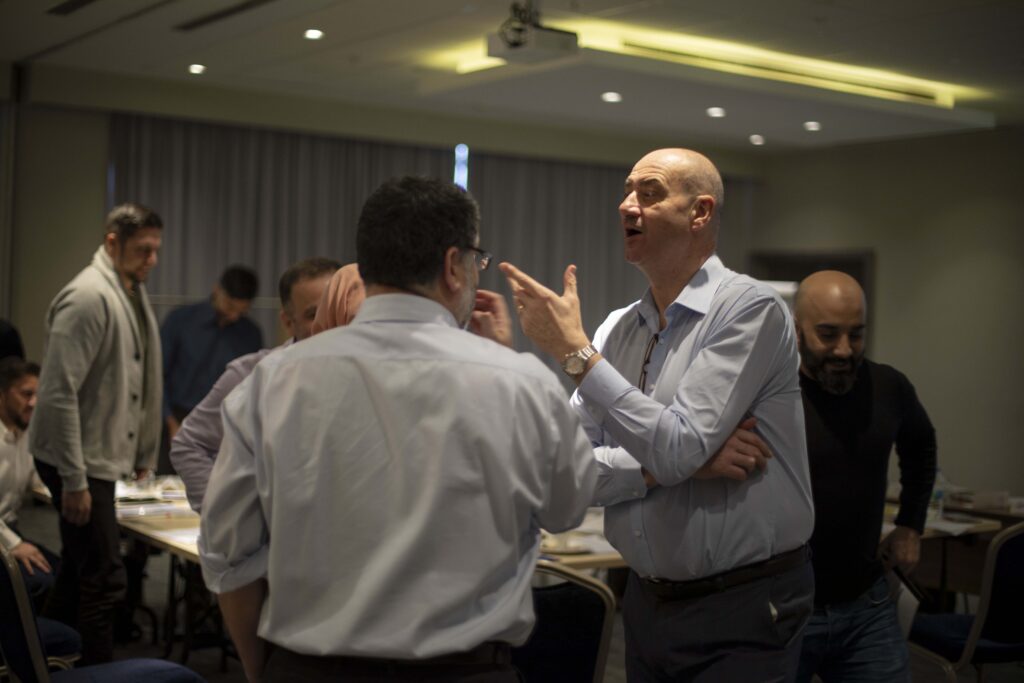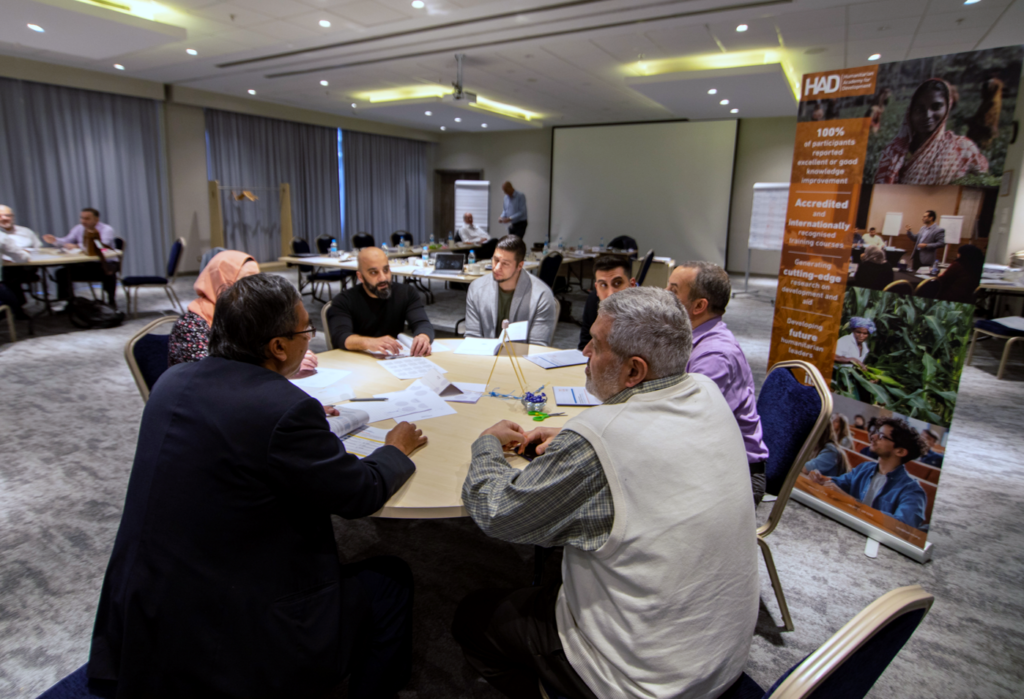Table of Contents
An Islamic perspective on how to avoid negative effects of NGO programmes
November 6, 2019
The recent publication by House of Peace of a collection of stories from the field of humanitarian/development operations in Lebanon and Syria is a reminder that while humanitarian relief operations are far more cognisant of the potential negative effects of their work than was the case twenty years ago, negative effects do still occasionally happen.
Humanitarians, development professionals and peacebuilding actors all have stories of initiatives that have failed, projects that have unintentionally caused harm or people who have behaved in undignified ways.
A conflict sensitive approach to programming aims to prevent negatives effects and mitigate the damage if they occur, but what does an Islamic perspective on conflict sensitivity look like?
This blog explains Islamic Relief’s thoughts on the topic and offers some practical suggestions for busy professionals in the field or in headquarters.
Negative effects of programmes continue to be reported
The report by House of Peace highlights a number of negative effects that have been seen recently in Lebanon and Syria.
Although the following examples come from this report, Lebanon and Syria are neither unique nor unusual, there will be similar stories elsewhere and others besides.
Fraught aid distributions
“A local NGO team visited a camp and asked the residents to register their names and those of their neighbours for oil distribution.
One of the residents wasn’t present in the camp and his neighbours didn’t register his name. A verbal conflict started between neighbours and escalated to a physical one.
This tense relationship lasted for 8 months until one of the camp residents intervened and solved the conflict.” (Sadkni, 2019:8)
Aid distributions are often fraught with tension, especially between those who receive aid and those who do not but feel themselves to be just as needy.
These tensions can escalate into hostility between refugee and host communities and outright violence, especially when they reinforce existing divisions.
“In Wadi Khaled, a group of volunteers decided to organise some activities for kids during Eid Al-Fitr. Since their budget was limited, they decided that the activities will target refugee kids only.
During this implementation, kids from the local community felt frustrated because they were forbidden to participate, and they sabotaged the team possessions and eventually forced them to leave the area.” (Sadkni, 2019:13).
Deciding on aid criteria together with local stakeholders and communicating criteria clearly can help to mitigate this tension, but it may not eliminate it entirely. Understanding the divisions in a community is important because projects can be altered to work across dividing lines rather than reinforcing them.
In the story above, a more sensitive approach would have been to organise activities for refugee and local children together and use the activity to break down prejudices and tensions between the two groups.

Aid distributions can also be fraught with tension when distribution staff or recipients engage in poor behaviour, such as striking recipients off an aid list out of spite or verbally abusing staff because of perceived affronts to someone’s dignity.
The asymmetrical power relations between those giving and those receiving aid can exacerbate problems of malpractice.
“During an outdoor activity, a group of youth approached female volunteers and harassed them verbally.
The volunteers didn’t know that the community was very conservative, so they didn’t take this into consideration in the way how they dressed up.
Moreover, they chose the location of the activity to be next to the mosque. The music and the noise bothered the Sheikh who went out and forced people to boycott the activity.” (Sadkni, 2019:10)
The values and cultural differences between international NGOs and local communities can cause problems in perception and action.
For example, Muslim communities may view the promotion of human rights as an attempt to undermine Islamic values and local culture and promote ‘Westernisation’ of their society.
Women’s empowerment projects tend to be particularly sensitive. Overcoming these problems of perception is possible by staff with excellent knowledge of the local culture, the ability to communicate ideas and meaning between different languages and the ability to build trust between different stakeholders.
Elitism and perceived bias
Very often staff within international organisations are recruited from a country’s highest strata of educated, English-speaking elites. Staff are then not just from a different social class to the recipients of aid or development projects, but they are very often also from an ethnic or religious group that has historically benefitted from preferential access to education.
This can make it difficult for them to build trust with local communities and it can create negative perceptions of NGOs by suggesting they are biased in their recruitment processes.
There are many more stories and examples from Lebanon and Syria in the House of Peace report, as well as some excellent recommendations for improving the delivery of humanitarian and development programmes in these countries, but being conflict sensitive is easier said than done.
Context sensitivity within Islamic Relief
One of Islamic Relief’s five core values is Ihsan (excellence) and in our day to day engagement with local communities we strive to do the best possible work that we can.
An increasingly important issue for our operations in fragile and conflict-affected states is sensitivity to the context we work in to avoid exacerbating tensions and making the situation worse.
Do No Harm as a guiding principle for humanitarian action arose out of the ashes of the Rwandan genocide and has now developed into conflict/context sensitivity.
This is a broader concept that applies to development and peacebuilding practitioners as well as humanitarians and seeks to not just avoid negative effects but also seize opportunities to reduce social tensions and rebuild positive relationships.
Being context sensitive means taking the time to talk to a wide range of people in the places where we work to build a deeper understanding of the root causes of problems, the tensions beneath the surface, the divisions between different class, religious, ethnic or linguistic groups and the political and economic forces that exacerbate divisions or bring people together despite them.
This implies a humility in our engagement with communities. As stated in the Qur’an:
“Do not follow blindly what you do not know to be true: ears, eyes and heart, you will be questioned about all of these.
Do not strut arrogantly about the earth: you cannot break it open, nor match the mountains in height” (Q17:36-37)
It also implies a broader understanding of the context than one which might be assumed when we talk about ‘conflict’.
Focusing on ‘conflict’ too often limits discussion to armed groups and agents of violent conflict.
Islamic Relief’s toolkit for working in conflict states “In Islam, the goal of development is to create an environment that enables people to enjoy spiritual, moral and socio-economic well-being” (Salek, 2014:19). In order to work towards this environment, Islamic Relief has adopted the Maqasid al-Shari’ah which places human dignity at the centre of an Islamic framework for development.
There are five crucial dimensions of human development in this framework:
faith (deen), life (nafs), the intellect (aql), posterity (future generations, nasl) and wealth (maal). The Qur’anic notion of justice (adl) is related to this framework because it states that peace cannot be attained without justice, meaning also social and economic justice.
When we strive towards the objectives of the Maqasid al-Shari’ah we are urged in Islamic legal theory to seek benefit and reduce harm (through maslaha), thus we must look at the impact of our interventions on all of these five areas of life (Salek, 2014:19).
“My Lord, increase me in knowledge” (Q20:114)

Ideally, we would seek a deep understanding of the context where we work before designing a project so that we are as sure as we can be that it is sensitive to local dynamics, appropriate to the cultural context, meets identified needs and is sustainable over the long term. How do we do this? We use tools to map the context (problem tree, historical timeline, geographic mapping, stakeholder mapping, connectors and dividers etc.) and should, ideally, engage local people in our analysis discussions to ensure we have understood all of the local sensitivities in the project location.
The constant challenge, though, is the lack of time available to do a good enough analysis before a project is designed and a funding proposal written.
Projects are often designed very rapidly and locked into place once funding is received.
This makes it difficult to change a project when we realise that things are not working out as expected or we can see a better way of delivering and supporting sustainable human development.
This challenge is common to all NGOs and it is here to stay, at least in the short term. So here are five simple suggestions for busy professionals seeking to integrate context sensitivity into their organisation’s work.
First, instead of trying to do a context analysis for every project, cluster projects together into geographic regions or thematic issues and do an annual analysis of that region or theme.
While some of the finer detail may be lost, the main issues will be captured and considered. If there is a lack of confidence in the office in doing a context analysis, employ an expert consultant for a few days to help.
Schedule in annual reviews of the analysis because things do change and make sure that you use the analysis to review the appropriateness of projects.
Second, put a fixed agenda point into project review meetings to review the project’s interaction with the context.
Third, focus on improving project risk assessments and broaden understandings of risk to encompass the risk of unintended negative effects on relationships between social groups as well as fiduciary, reputational and project risks.
Fourth, ensure project monitoring and evaluation mechanisms (indicators, stakeholder meetings and evaluation terms of reference) look for unintended negative effects of projects. They could also look for unanticipated opportunities to build positive social relations and collective approaches to peace.
Fifth, engage in country-level or sub-national inter-agency coordination mechanisms. These are often a valuable source of contextual information about the places where we work and they very often provide experience, advice and a coordinated approach to some of the many dilemmas our field staff face.
A famous hadith states “Tie your camel and trust in Allah”.
This hadith means that people should strive their utmost to be prepared within the limits of their ability and power, after which they should put their trust in Allah to bring their striving to its conclusion. So before we trust in Allah to bring our humanitarian or development work with local communities to its desired conclusion, we must first do all we can to plan and prepare well.
See Islamic Relief’s publication ‘Working in Conflict: A Faith Based Toolkit for Islamic Relief’ for more guidance about how to plan and prepare projects in fragile and conflict-affected places.
Dr. Sylvia Brown
Conflict Advisor, International Programmes Division







